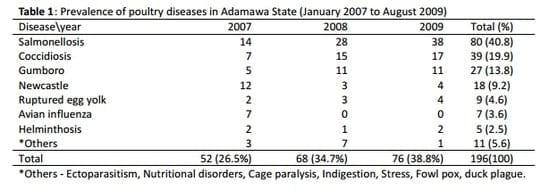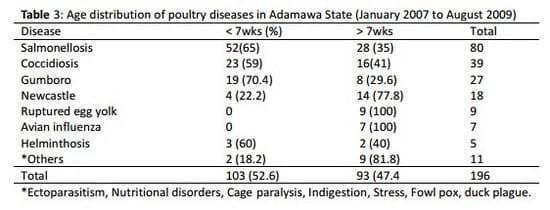INTRODUCTION
Poultry industry is one of the fastest growing agribusiness industries in Nigeria. In Nigeria, chicken are the most important and patronized of the poultry species in terms of number and quality development (Olabode et al., 2008). With increased acceptance of chicken eggs and meat, the demand for these products is ever increasing (Geidam et al., 2006). The Nigerian poultry industry is characterized by few hatcheries (concentrated mainly in southern parts of the country) and many small holder farmers (scattered across the nation). Desperation on the part of the farmers and agents especially during peak demands result in sourcing and supply of chicks from unknown and/or of questionable medical history (Geidam et al., 2006).
Consequently, commercial poultry farms are exposed to various poultry diseases which could be prevented if properly analyzed by researchers. Reports on various poultry diseases occurring in some parts of this country have been documented (Abdu et al., 1985; Garba, 2005; Saidu et al., 2006; and Olabode et al., 2008). Information on the prevalence of poultry diseases that pose a threat to poultry production in Adamawa State is very scanty, hence the need for this study.
MATERIALS AND METHODS
Data collection
Data on the postmortem cases from the records of the Diagnostic and Investigation Laboratory of the National Veterinary Research Institute (NVRI), Yola Adamawa State for three years (January 2007 and August 2009) were retrieved and analyzed. Diseases were diagnosed based on flock history, clinical signs and postmortem findings (Salmonellosis, New castle disease, Gumboro, Ruptured egg yolk, others) and in some cases (avian influenza, helminthosis and coccidiosis) by laboratory
confirmation. The seven suspected cases of avian influenza were sent to Viral Research Department of the NVRI, Vom for confirmation. The distribution pattern of the poultry diseases diagnosed were analyzed using proportional (percentage) data presentation.
RESULTS AND DISCUSSION
A total of 196 post-mortem cases of poultry diseases were diagnosed and recorded during the study period (52 cases in 2007, 68 in 2008 and 76 in 2009). This gives an average of 65 cases annually. The year 2009 recorded the highest number of cases 76 (38.8%), while the year 2007 recorded the lowest with 52(26.5%) cases (Table 1). This may be as a result of sensitization of poultry farmers to report any clinical or dead cases of poultry diseases to the nearest NVRI laboratory since the upsurge of avian influenza in 2006 in the country. Hence the steady increase in cases reported/recorded from 2007 to 2009. It also appeared that Salmonellosis constitutes the most prevailing poultry disease during the reporting period with 80 (40.8%) cases (Table 1). Similarly, year 2009 recorded the highest cases of Salmonellosis 38 (47.5%) while year 2007 recorded the lowest 14 (17.5%) of Salmonellosis (Table 1). This may be attributed to the increased in the demand for day-old-chicks since the destruction of parent stocks across the country in 2006 due to the outbreak of avian influenza for the first time in the country (Ocholi et al.,2006). Desperation in looking for day-old-chicks resulted in supply of chicks from unknown source and inadequate history as asserted by Geidam et al (2006). Consequently, the flocks supply to Adamawa and indeed Nigeria are faced with such hatchery diseases like Salmonellosis (Pullorum and Fowl Typhoid diseases) (Geidam et al, 2006). It was noted that 52 (65%) of the Salmonellosis occurred in birds less than 7 weeks old (Table 3). Most of the cases of Salmonellosis (though not reflected in the tables) occurred concurrently with either Gumboro, and /or Coccidiosis and Ruptured egg yolk (REY) in older birds. This further elicit the fact that the problem of Salmonellosis is associated with hatchery management such that majority of cases occurred in young birds and that slightest immunosuppression due to other diseases as mention above will aggravate the appearance of Salmonella infection and dead in the flocks. The monthly distribution of cases indicates that January had the highest (37) cases; November has none and December had the least (3) cases (Table 2). This may be explained as to the stocking of day-old-chicks in January as been practice by poultry farmers in Adamawa State assuming that the weather is a bit cool. But due to cumulating diseases and other stressors; more birds came down with infection and died in January. On the other hand in November and December which are festive months of Sallah and Christmas, farmers have sold their stocks (Broilers, Cockerels and spent layers) thus, no bird available to manifest various infections/ diseases hence the lower prevalence of diseases in these months. All the diseases reported in this study are important and have been reported in other parts of this country (Abdu et al., 1985; Garba, 2005; Saidu et al., 2006; Olabode et al., 2008). However, Salmonellosis appeared to be a threat to commercial poultry production in Adamawa State in terms of both morbidity and mortality Coccidiosis which is the second most prevailing disease (Table 1) appears to occur more between the months of June and September (Table 2). This could be attributed to the peak period of rainy season with increase humidity which favours hatching of the oocyst and reinfection. It should also be noted that there was increase in the number of cases of Gumboro from 5 cases in 2007 to 11 cases each in 2008 and 2009 (Table 1). The probable reason could be that poultry farmers re-directed their focus on vaccination against New castle disease (NCD) which mimics avian influenza (hence the drop in NCD cases from 12 in 2007 to 4 in 2009); neglecting the vaccination against Gumboro hence the increase in cases of Gumboro from 2007 to 2009.



In conclusion, we have identified Salmonellosis (Pullorum disease and Fowl typhoid) as a major threat to poultry production in Adamawa State and hatchery problems is associated with the result obtained. It is recommended that the relevant agency (Federal Department of Livestock-Abuja) should employ stringent measures to monitor the quality of day old chicks and parent stock supply to farmers in this country.
REFERENCES
Abdu PA, George JB, Abdullahi SU & Umoh JU (1985). Poultry diseases diagnosed at the avian clinic Ahmadu Bello University, Zaria: a retrospective study. Nigerian Veterinary Journal, 14(1): 63-65.
Garba A (2005). Infectious Bursal Disease outbreak in vaccinated poultry flock in Katsina, Nigeria: a case report. Proceedings of the 42nd Congress of the Nigerian Veterinary Medical Association, 14th–18th November, 2005, University of Maiduguri. Pp 27-29.
Geidam YA, Bukar MM, & Ambali AG (2006). Chick quality control: a key to sustainable poultry production in Nigeria. Nigerian Veterinary Journal, 27(2): 1-6.
Ocholi RA, Oyetunde IL, Kumbish PR, Odugbo MO, Ta’ama L, Usman MG, Ogbe A, Waziri E, Ahmed J, Joannis TM, Ularamu HG, Shittu IA, Egbuji AN, Suleiman LK, Makinde AA, & Lombin LH (2006). Epidemiology of an outbreak of highly pathogenic avian influenza caused by the virus sub-type H1N5 in Nigeria in 2006. Vom J. Vet. Sci. special edition: 1-11
Olabode HOK, Eghafona NO & Iyoha H (2008).A retrospective (2004-2006) study of poultry diseases diagnosed at Benin, Edo State. Nigerian Veterinary Journal, 29(1): 76-80.
Saidu L, Abdu PA, Tekdek LB, Umoh JU, Usman M & Oladele SB (2006): Newcastle Disease in Nigeria. Nigerian Veterinary Journal, 27(2): 23-32.
This article was originally published at Sokoto Journal of Veterinary Sciences (2010) Vol.8 (1):50-52. Engormix thanks for this contribution.










